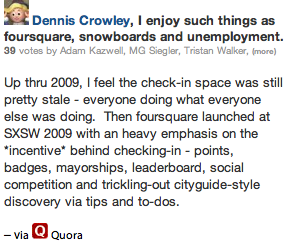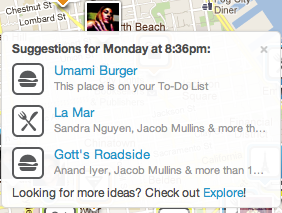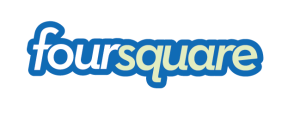I quickly found myself obsessed with creating products; trying to follow the work of Steve Jobs and other product leaders that did it best. With so many approaches to product management, I found but a single common philosophy that bound all successful products together:
- Identify product opportunities.
- Create products to seize them.
As a disclosure, I have no affiliation with Foursquare whatsoever…but I’ve had a man-crush on their founders for a while and can assure you their approach exemplifies the philosophy above.
- 1999: Mobile browsers and SMS
Recognizing the opportunity that mobile web browsers and SMS provide, Dennis Crowley conceived the check-in and began working on a mobile social network built around it called Dodgeball.
The service was acquired by Google in 2005, but would soon collapse due to lack of support, leading Dennis and co-founder Alex Rainert to quit in frustration.
- The App Store & SDK
The 2007 launch of the iPhone had only induced half the smartphone revolution; the other half arrived with the iOS SDK in 2008. Mobile apps created entirely new user behavior, and new user behavior creates incredible product opportunities.
Among them would be the ability to turn common occurences like arriving at local bars and restaurants into a game, and the desire to broadcast the location of our fancy new devices.
The check-in was ripe for reinvention.
With services like BrightKite, FireBall and Loopt already extending the work of Dodgeball, Dennis and new partner Naveen Selvadurai would consider retooling it with iOS. - Twitter
Foursquare, like all new services, would need users. Twitter – a previous SXSW darling – had built a lot of buzz, but many still didn’t get it.
Utilizing this as a marketing opportunity, Foursquare would make it seamless to Tweet check-ins and accomplishments. Early users might remember the days when their Twitter streams were flooded with check-ins, sparking Foursquare’s initial virality.
The company would regularly adjust its channel syndication strategy from Twitter to Facebook to push notifications — constantly finding the balance between spam and great marketing. -

- Gamification
Foursquare’s three basic forms of game mechanics appealed to distinct groups of users, and were critical to their success in user engagement and retention.
❶ Badges – Early users of a service rarely bring their entire social graph with them. Without friends to interact with, Foursquare users collected badges for individual accomplishments — keeping them engaged during their initial solo experience.
❷ Mayorships – Once a critical mass was reached, “friendless” users could be engaged through interactions with strangers. Unacquainted Foursquare users compete to become the “mayor” of a venue, claim territory, and allow merchants to establish loyalty.
❸ Social Competition – By the time users became bored with the basic badges, most had enough friends to form a social graph. Competing for points and position on the leader board became the new focus. And the utility of knowing friends’ locations became a draw for those growing tired of games. - Crowd-sourcing in the race for a place-base
In late 2010, an all-out war was brewing in the location space.
But while people went to Google or Yelp for phone numbers and long-form reviews, Foursquare focused on simplifying social interactions and mobile venue-creation, leading to growth in unexpected places abroad. The most passionate venue-curators were given “Superuser” status, and the ability to spend their time fine-tuning the venue database.
Today more than 50% of Foursquare’s users are outside the US, with highly active groups in places like Southeast Asia — where other major players have no clear plans on entering. - In 2010 Yahoo!, Facebook and Microsoft were vying to acquire Foursquare for a rumored $100-150 million, despite the app having barely a million users. A service with an applied value of more than $100 per user was unprecedented, and spoke volumes to the value of a highly engaged, geo-located user base.
- Merchant platform and specials
Instead of employing a massive salesforce and entering the daily-deals space, Foursquare opted to bypass the race and once again leverage their passionate community. Merchants could create specials themselves, keep profits, and directly form relationships with customers.
This effectually closed the loop of Foursquare’s value proposition — from location-based gaming, to real value for users. - Brands
With successful solutions for small businesses, it wouldn’t be long before brands would jump on board — pushing Foursquare into the mainstream.
By slowly and tastefully rolling out branded badges, tips, and promoted specials, the relationship between business and users on Foursquare is arguably stronger than any other network — and you’d be hard-pressed to find users that even feel they’re being advertised to.
Foursquare’s “real world” focus may even lead to a value per impression higher than any other social network. Their mobile users are simply more likely to “go out and do stuff” than users spending hours online. - Answer the age-old question: “So…whatcha wanna do?”
With last week’s updates, Foursquare’s recommendations are smarter than ever before. It’s now obvious that Foursquare knows the most about me, and that’s the most important factor in social monetization these days.

The updates also include the pivotal ability to explore outside your current location – a direct threat to Yelp and Google – and it won’t be long before Foursquare venues begin appearing prominently in search results for businesses.
Their success must also obviously be attributed to other details like excellent design, witty copy, tenacious biz-dev/PR, and epic marketing during major events. But winning one of the most competitive spaces in tech, surviving where Gowalla couldn’t, and when everyone said they’d fall to Facebook…took sheer product execution and opportunism.
And there should be no doubt that Foursquare’s best work lies ahead. By looking closely at the past three years, we can attempt to extrapolate:
What’s next for Foursquare?
Events & Plans
Foursquare already lets you specify events when checking in at major venues. But to meet their vision of “making cities easier to use”, they could re-invent the very foundation of their platform: the check-in. If Foursquare allows people to broadcast their plans ahead of time, there’s no reason why they can’t be what Plancast tried to become, “Foursquare for the Future“.The first step will be the inclusion of events happening tonight in Foursquare’s Explore section. But eventually, you can probably expect notifications like, “You haven’t hung out with Anand in a while, would you like to reserve dinner with him at Ryoko tomorrow at 9?”.
Foursquare’s official line on adding events to Explore: We’ve seen that people love checking into events — hundreds of thousands have checked in since we officially launched events last year. We never share specific product plans ahead of time, but we’re focused on designing product around the intersection of people, place, and time, and events are naturally a big part of that.
Deals
Foursquare supposedly partners with Groupon, LivingSocial, and others to distribute deals — but in trying to locate these deals within Foursquare, only ScoutMob deals appear to be active. Why are the daily-deals companies so sparse? They may feel they’re becoming middlemen to merchants, who’d probably prefer creating specials on Foursquare without forfeiting revenue.Dennis himself expects the deals companies be cut out of the equation — which could be accomplished through a rumored partnership with daily-deal aggregator Yipit.
Combining discounts with the Plans feature above would be even more enticing for users.
Payments
Anyone who’s tried Square’s side project, Card Case, has felt the future of mobile payments — and knows it feels a lot like a check-in. Foursquare already has a popular integration with American Express cards for discounts, as well as the ability to view restaurant menus and prices.They could attempt other ways to build payments into the check-in process, like partnering with Square (ran by Dennis’s buddy Jack Dorsey) or leveraging their NFC capabilities launched last week.
But mark my words: Soon, when you check in to Crave and see the Mac & Cheese for $6, you’ll be able to order and pay for it all from within Foursquare. When I asked Alex Rainert – now Foursquare’s Chief Product Officer – about plans for payments, he could only say, “We’re always looking for new ways to help our community save money and unlock rewards. Stay tuned.”
Real-time location based Q&A, chat, or dating.
Startups like LocalMind have been trying to build these on top of Foursquare for a while, and the time might finally be ripe for Foursquare to get in the game.Imagine asking people checked into JFK if they wanted to split a cab to midtown. Or asking people checked into The Bubble Lounge, “How long is the line?” or, “are there lots of cute chicks there?” With the answerer being awarded 5 Foursquare points.
As for dating, a casual “crush” feature to connect strangers was part of Dodgeball years ago, and I wouldn’t be surprised if it’s somewhere in Foursquare’s product backlog today.
One real-world app to rule them all.
Mobile users will soon grow tired from app-fatigue, and Foursquare aims to provide the solution. Think making OpenTable reservations within Foursquare. Or checking into a Zipcar lot and selecting your car in-app. Or checking in to a hotel actually checks you in at your hotel. At the rate Foursquare is moving, the 2012 Scoble envisioned is not so far off.Source: TechCrunch | Almost Three: A Brief History Of Foursquare Time (And A Look At Its Future)


0 comments:
Post a Comment